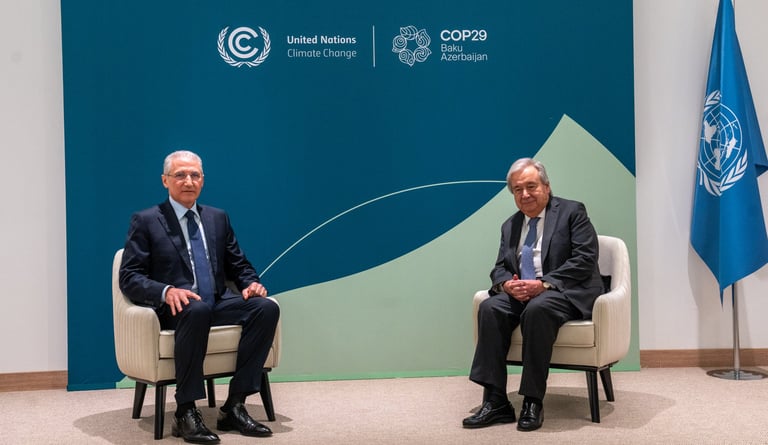COP29 Opens in Baku
An Urgent Call to Action on Climate Finance, Emissions Reduction, and Carbon Markets
Zivaiclimate
11/12/20243 min read


Detailed First-Day Highlights and Updates:
Opening Ceremony and Urgency from Leaders
On November 11, 2024, the COP29 conference opened with urgent calls for decisive action from global leaders and environmental advocates in Baku, Azerbaijan. Simon Stiell, the UNFCCC Executive Secretary, stressed the necessity of strengthening climate finance, warning that failing to support developing nations and frontline communities could exacerbate the global climate crisis. Stiell highlighted COP29 as a "critical juncture" for meeting climate goals, urging countries to not only set but also implement ambitious goals, with a particular emphasis on financial support and global cooperationPush for a New Climate Finance Target
A central focus of the first day’s discussions was on establishing a new, ambitious climate finance target to support adaptation, resilience, and sustainable development in vulnerable countries. Delegates are working toward a concrete financing plan that encourages wealthier nations to fulfill and exceed the annual $100 billion commitment made in the Paris Agreement. This funding is critical for helping nations build climate-resilient infrastructure, transition to renewable energy, and respond to natural disasters and climate-induced damages, which have disproportionately impacted lower-income countries. UNFCCC, Graphic OnlineAdvancing International Carbon Markets: Article 6 of the Paris Agreement
One of the major agenda items at COP29 is the development of robust international carbon market guidelines under Article 6 of the Paris Agreement. Carbon markets allow countries to trade emissions reductions, which could accelerate overall reductions and foster investment in clean energy projects. However, many developing nations have voiced concerns about how carbon markets are regulated and whether their implementation will genuinely support emissions reduction without compromising environmental integrity. These concerns are prompting discussions on safeguards against "double counting" and transparency to ensure these mechanisms achieve real, measurable climate benefitsHighlighting Nationally Determined Contributions (NDCs) for 2025
With the IPCC’s recent findings that global warming may surpass 1.5°C by the 2030s, countries are urged to enhance their NDCs ahead of the 2025 revision deadline. The conference highlighted that achieving the 1.5°C target requires bold and quantifiable commitments, particularly in phasing out fossil fuels and investing in clean energy infrastructure. Early discussions emphasized the need for each nation’s climate action plans to be economy-wide, with financial, technical, and policy support to ensure that lower-income countries can pursue ambitious climate action alongside wealthier nations. Graphic Online, UNFCCCInclusion of Youth, Indigenous Voices, and Civil Society
COP29 has seen over 50,000 delegates, including youth activists, Indigenous leaders, climate scientists, and representatives from civil society, gathering to present their insights and advocate for policies that prioritize climate justice and equitable transition strategies. Indigenous representatives emphasized the need to integrate traditional knowledge in climate adaptation, particularly in regions that rely on ecosystems for their livelihoods. Youth delegates, meanwhile, pushed for intergenerational equity, stressing that today’s policies will impact their futures and calling for ambitious commitments that go beyond pledges Global Times, UNFCCCInnovations in Climate Technology and Climate-Resilient Infrastructure
Technology and innovation emerged as key areas of focus, with several countries showcasing advancements in renewable energy, carbon capture, and sustainable infrastructure. A “Technology Showcase” featured innovations from various sectors, highlighting how emerging technologies can accelerate both mitigation and adaptation efforts. Experts pointed to artificial intelligence, clean energy, and circular economy strategies as transformative forces that can help reach emissions goals while supporting economic growth in developing countries.UNFCCC, Global TimesAddressing Loss and Damage
Loss and damage, a contentious topic in past COPs, is receiving heightened attention as countries discuss formalizing support mechanisms to assist those most affected by climate impacts. The newly established Loss and Damage Fund aims to provide financial resources for rebuilding and recovery after climate-induced disasters. However, the fund's effectiveness will depend on ensuring rapid disbursement and equitable allocation. The discussions underscored the need for donor countries to contribute generously and for the fund’s operational rules to be finalized during COP29 to offer timely assistance to vulnerable nations(Graphic Online, UNFCCC)
COP29’s first day set the stage for a focused and inclusive climate dialogue, with leaders across sectors committing to transformative action. The ambitious agenda, while challenging, reflects the urgency of global climate objectives and the collective will to address the climate crisis comprehensively. The conference will continue over the next two weeks, tackling complex issues like emissions reduction, carbon markets, and long-term adaptation strategies, aiming to translate commitments into actionable, enforceable plans that can make a difference.
photo credits cop 29 Azerbaijan
